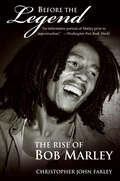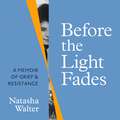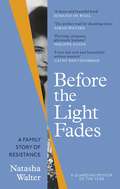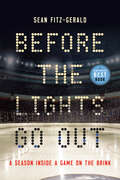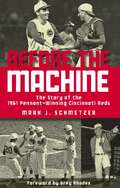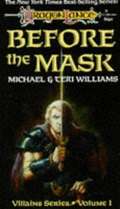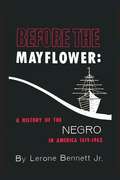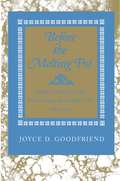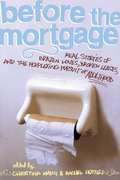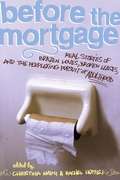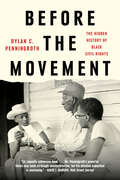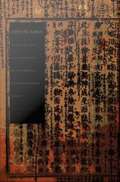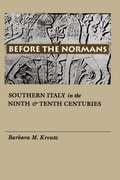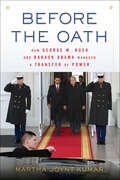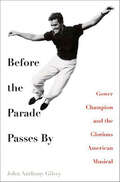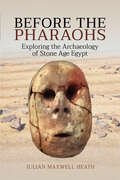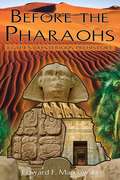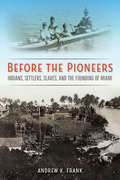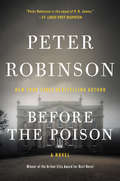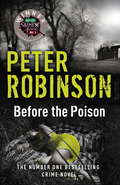- Table View
- List View
Before the Legend: The Rise of Bob Marley
by Christopher John FarleyBob Marley was a reggae superstar, a musical prophet who brought the sound of the Third World to the entire globe. Before the Legend: The Rise of Bob Marley goes beyond the myth of Marley to bring you the private side of a man few people ever really knew. Drawing from original interviews with the people closest to Marleyincluding his widow, Rita, his mother, Cedella, his bandmate and childhood friend, Bunny Wailer, his producer Chris Blackwell, and many others—Legend paints an entirely fresh picture of one of the most enduring musical artists of our times. This is a portrait of an artist as a young man, from his birth in the tiny town of Nine Miles in the hills of Jamaica, to the making of his debut international record, "Catch a Fire." We see Marley on the tough streets of Trench Town before he found stardom, struggling to find his way in music, in love and in life, and we take the wild ride with him to worldwide acceptance and adoration. From the acclaimed journalist, Christopher John Farely, the author of the bestselling AALIYAH and the reporter who broke the story on Dave Chappelle's retreat to South Africa, Legend is bursting with fresh insights into Marley and Jamaica, and is the definitive story of Marley's early days.
Before the Light Fades: A Memoir of Grief and Resistance - 'Deeply affecting and unexpectedly inspiring’ Sarah Waters
by Natasha Walter'Deeply affecting and unexpectedly inspiring... the perfect read for daunting times' SARAH WATERS'Beautiful... illuminating and healing' JULIA SAMUEL'Eloquent, piercing, gloriously humane' PHILIPPE SANDSOne day in December, Natasha Walter's mother Ruth took her own life.At first, the grief and guilt that Natasha felt were overwhelming. As the author of feminist books and the founder of the charity Women for Refugee Women, Natasha had always been active in movements for social justice. But in the aftermath of her mother's suicide, her personal grief intertwines with a sense of political despair.Gradually, she starts to search back through Ruth's history, trying to understand how her life led to this death. She explores Ruth's own involvement as a young woman in the nuclear disarmament movement of the 1960s. Even though Ruth had been brought up to be a conventional young woman, she chose to take huge risks and break the law in order to stand up for what she believed was right. This was where Ruth met and fell in love with Natasha's father, the anarchist writer Nicolas Walter.Natasha also explores the history of Ruth's parents, particularly the story of her grandfather Georg. He was involved in anti-Nazi resistance in the 1930s in Germany, was imprisoned for three years and then went on the run across Europe. Eventually he got to safety, and never spoke again about his experiences.In thinking back through the years, Natasha comes to a deeper and more hopeful understanding of the legacy that her parents and grandparents leave her. No longer overwhelmed by grief, she comes to value the courage of past generations. She steps back into activism, and values the beauty of everyday life once again.Without false hope, this book explores why it is always important to stand up for what you believe is right, even when success is far from assured. This is a memoir that is honest about loss, but also searches for what is valuable in the legacy of one family that lived through some of the great crises of the twentieth century. It will resonate with those grappling with the loss of hope in these challenging political times, as well as those who are living in the shadow of bereavement.
Before the Light Fades: A Memoir of Grief and Resistance - 'Deeply affecting and unexpectedly inspiring’ Sarah Waters
by Natasha Walter'Deeply affecting and unexpectedly inspiring... the perfect read for daunting times' SARAH WATERS'Beautiful... illuminating and healing' JULIA SAMUEL'Eloquent, piercing, gloriously humane' PHILIPPE SANDSOne day in December, Natasha Walter's mother Ruth took her own life.At first, the grief and guilt that Natasha felt were overwhelming. As the author of feminist books and the founder of the charity Women for Refugee Women, Natasha had always been active in movements for social justice. But in the aftermath of her mother's suicide, her personal grief intertwines with a sense of political despair.Gradually, she starts to search back through Ruth's history, trying to understand how her life led to this death. She explores Ruth's own involvement as a young woman in the nuclear disarmament movement of the 1960s. Even though Ruth had been brought up to be a conventional young woman, she chose to take huge risks and break the law in order to stand up for what she believed was right. This was where Ruth met and fell in love with Natasha's father, the anarchist writer Nicolas Walter.Natasha also explores the history of Ruth's parents, particularly the story of her grandfather Georg. He was involved in anti-Nazi resistance in the 1930s in Germany, was imprisoned for three years and then went on the run across Europe. Eventually he got to safety, and never spoke again about his experiences.In thinking back through the years, Natasha comes to a deeper and more hopeful understanding of the legacy that her parents and grandparents leave her. No longer overwhelmed by grief, she comes to value the courage of past generations. She steps back into activism, and values the beauty of everyday life once again.Without false hope, this book explores why it is always important to stand up for what you believe is right, even when success is far from assured. This is a memoir that is honest about loss, but also searches for what is valuable in the legacy of one family that lived through some of the great crises of the twentieth century. It will resonate with those grappling with the loss of hope in these challenging political times, as well as those who are living in the shadow of bereavement.
Before the Lights Go Out: A Season Inside a Game on the Brink
by Sean Fitz-GeraldA love letter to a sport that's losing itself, from one of Canada's best sports writers.Canadian hockey is approaching a state of crisis. It's become more expensive, more exclusive, and effectively off-limits to huge swaths of the potential sports-loving population. Youth registration numbers are stagnant; efforts to appeal to new Canadians are often grim at best; the game, increasingly, does not resemble the country of which it's for so long been an integral part. These signs worried Sean Fitz-Gerald. As a lifelong hockey fan and father of a young mixed-race son falling headlong in love with the game, he wanted to get to the roots of these issues. His entry point: a season with the Peterborough Petes, a storied OHL team far from its former glory in a once-emblematic Canadian city that is finding itself on the wrong side of the country's changing demographics. Fitz-Gerald profiles the players, coaches and front office staff, a mix of world-class talents with NHL aspirations and Peterborough natives happy with more modest dreams. Through their experiences, their widely varied motivations and expectations, we get a rich, colourful understanding of who ends up playing hockey in Canada and why. Fitz-Gerald interweaves the action of the season with portraits of public figures who've shaped and been shaped by the game: authors who captured its spirit, politicians who exploited it, and broadcasters who try to embody and sell it. He finds his way into community meetings full of angry season ticket holders, as well as into sterile boardrooms full of the sport's institutional brain trust, unable to break away from the inertia of tradition and hopelessly at war with itself. Before the Lights Go Out is a moving, funny, yet unsettling picture of a sport at a crossroads. Fitz-Gerald's warm but rigorous journalistic approach reads, in the end, like a letter to a troubled friend: it's not too late to save hockey in this country, but who has the will to do it?
Before the Machine
by Greg Rhodes Mark J. SchmetzerThe Big Red Machine dominated major league baseball in the 1970s, but the Cincinnati franchise began its climb to that pinnacle in 1961, when an unlikely collection of cast-offs and wannabes stunned the baseball world by winning the National League pennant. Led by revered manager Fred Hutchinson, the team featured rising stars like Frank Robinson, Jim O'Toole, and Vada Pinson, fading stars like Gus Bell and Wally Post, and a few castoffs who suddenly came into their own, like Gene Freese and 20-game-winner Joey Jay.In time to celebrate the 50th anniversary of their pennant-winning season, the amazing story of the "Ragamuffin Reds" is told from start to finish in Before the Machine. Written by long-time Reds Report editor Mark J. Schmetzer and featuring dozens of photos by award-winning photographer Jerry Klumpe of the Cincinnati Post & Times Star, this book surely will be a winner with every fan in Reds country and coincides with an anniversary exhibit at the Cincinnati Reds Hall of Fame and Museum.Through interviews and research, Before the Machine captures the excitement of a pennant race for a team that had suffered losing seasons in 14 of the past 16 years. Schmetzer also beautifully evokes the time and place-a muggy Midwestern summer during which, as the new song of the season boasts, "the whole town's batty for that team in Cincinnati." Led by regional talk-show star Ruth Lyons (the Midwest's "Oprah") fans rallied around the Reds as never before.The year didn't begin well for the team. Budding superstar Frank Robinson was arrested right before spring training for carrying a concealed weapon, and long-time owner Powel Crosley Jr., died suddenly just days before the start of the season. Few experts-or fans-gave the Reds much of a chance at first place anyway. With powerhouse teams in Los Angeles, San Francisco, and Milwaukee, the National League pennant was unlikely to fly over Cincinnati's Crosley Field.But manager Hutchinson somehow galvanized his motley crew and led them to victory after victory. Joey Jay, who had languished with the Braves, mowed down hitters while his rotation mates O'Toole and knuckleballer Bob Purkey did the same. The team also featured a dynamic duo in the bullpen in Bill Henry and Jim Brosnan, whose book about the season, Pennant Race, became a national bestseller the following year. As the rest of the league kept waiting for the Reds to fade, Hutch's boys kept winning-and finally grabbed the pennant.Though they couldn't continue their magic in the World Series against the Yankees, the previously moribund Reds franchise did continue to their success throughout the decade, winning 98 games in 1962 and falling just short of another pennant in 1964. They established a recipe for success that would lead, a few years later, to the emergence of the Big Red Machine.
Before the Mask (Dragonlance: Villains, Book 1)
by Michael Williams Teri WilliamsIn the bleak Khalkist Mountains on a stormy winter night, a child is born amid hard words, ill will, and the ominous prophecy of a druidess. Young Verminaard grows up unlovely and unloved, trading friends and family for a dark romance with an evil, mysterious Voice and the sinister weapon it comes to inhabit. Michael and Teri Williams, long known for their poems, novels, and stories in the continuing DRAGONLANCE® saga reveal the origins of the evil cleric Verminaard. The Villains Series explores the corrupted origins of the malevolent minions of Takhisis, Queen of Darkness.
Before the Mayflower: A History of the Negro in America, 1619-1962
by Lerone Bennett2016 Reprint of 1962 Edition. Full facsimile of the original edition, not reproduced with Optical Recognition Software. Reprint of the first edition of this landmark title. The black experience in America--starting from its origins in western Africa up to 1961--is examined in this seminal study from a prominent African American figure. The entire historical timeline of African Americans is addressed, from the Colonial period through the civil rights upheavals of the late 1950s to 1961, the time of publication. "Before the Mayflower" grew out of a series of articles Bennett published in Ebony magazine regarding "the trials and triumphs of a group of Americans whose roots in the American soil are deeper than the roots of the Puritans who arrived on the celebrated Mayflower a year after a 'Dutch man of war' deposited twenty Negroes at Jamestown." Bennett's history is infused with a desire to set the record straight about black contributions to the Americas and about the powerful Africans of antiquity. While not a fresh history, it provides a solid synthesis of current historical research and a lively writing style that makes it accessible and engaging reading. After discussing the contributions of Africans to the ancient world, "Before the Mayflower" tells the history of "the other Americans," how they came to America, and what happened to them when they got here. The book is comprehensive and detailed, providing little-known and often overlooked facts about the lives of black folks through slavery, Reconstruction, America's wars, the Great Depression, and the civil rights movement. The book includes a useful time line and some fascinating archival images.
Before the Melting Pot: Society and Culture in Colonial New York City, 1664-1730
by Joyce D. GoodfriendFrom its earliest days under English rule, New York City had an unusually diverse ethnic makeup, with substantial numbers of Dutch, English, Scottish, Irish, French, German, and Jewish immigrants, as well as a large African-American population. Joyce Goodfriend paints a vivid portrait of this society, exploring the meaning of ethnicity in early America and showing how colonial settlers of varying backgrounds worked out a basis for coexistence. She argues that, contrary to the prevalent notion of rapid Anglicization, ethnicity proved an enduring force in this small urban society well into the eighteenth century.
Before the Mortgage
by Christina Amini Rachel HuttonThe swank apartment, the killer job, and the perfect boyfriend/girlfriend haven't yet fallen into place. Is this reallyadulthood? Welcome to life before the mortgage. Here's what you need to know. Christina Amini and Rachel Hutton have brought together the very best writing on this unpredictable -- and often hilarious -- time. This book features essays by celebrated writers such as Joel Stein, Thisbe Nissen, Thomas Beller, Foundmagazine's Davy Rothbart, and ReadyMade's Shoshana Berger, as well as exciting new writers.
Before the Mortgage
by Rachel Hutton Christina AminiThe swank apartment, the killer job, and the perfect boyfriend/girlfriend haven't yet fallen into place. Is this really adulthood? Welcome to life before the mortgage. Here's what you need to know. Christina Amini and Rachel Hutton have brought together the very best writing on this unpredictable -- and often hilarious -- time. This book features essays by celebrated writers such as Joel Stein, Thisbe Nissen, Thomas Beller, Found magazine's Davy Rothbart, and ReadyMade's Shoshana Berger, as well as exciting new writers.
Before the Mortgage
by Rachel Hutton Christina AminiThe swank apartment, the killer job, and the perfect boyfriend/girlfriend haven't yet fallen into place. Is this really adulthood? Welcome to life before the mortgage. Here's what you need to know. Christina Amini and Rachel Hutton have brought together the very best writing on this unpredictable -- and often hilarious -- time. This book features essays by celebrated writers such as Joel Stein, Thisbe Nissen, Thomas Beller, Found magazine's Davy Rothbart, and ReadyMade's Shoshana Berger, as well as exciting new writers.
Before the Movement: The Hidden History of Black Civil Rights
by Dylan C. Penningroth"Penningroth's conclusions emerge from an epic research agenda.... Before the Movement presents an original and provocative account of how civil law was experienced by Black citizens and how their 'legal lives' changed over time . . . [an] ambitious, stimulating, and provocative book." —Eric Foner, New York Review of Books Shortlisted for the Cundill History Prize Winner of the Merle Curti Social History Award from the Organization of American Historians Winner of the Ellis W. Hawley Prize from the Organization of American Historians Winner of the David J. Langum, Sr. Prize in American Legal History Winner of the James Willard Hurst Prize A prize-winning scholar draws on astonishing new research to demonstrate how Black people used the law to their advantage long before the Civil Rights Movement. The familiar story of civil rights goes like this: once, America’s legal system shut Black people out and refused to recognize their rights, their basic human dignity, or even their very lives. When lynch mobs gathered, police and judges often closed their eyes, if they didn’t join in. For Black people, law was a hostile, fearsome power to be avoided whenever possible. Then, starting in the 1940s, a few brave lawyers ventured south, bent on changing the law. Soon, ordinary African Americans, awakened by Supreme Court victories and galvanized by racial justice activists, launched the civil rights movement. In Before the Movement, acclaimed historian Dylan C. Penningroth brilliantly revises the conventional story. Drawing on long-forgotten sources found in the basements of county courthouses across the nation, Penningroth reveals that African Americans, far from being ignorant about law until the middle of the twentieth century, have thought about, talked about, and used it going as far back as even the era of slavery. They dealt constantly with the laws of property, contract, inheritance, marriage and divorce, of associations (like churches and businesses and activist groups), and more. By exercising these “rights of everyday use,” Penningroth demonstrates, they made Black rights seem unremarkable. And in innumerable subtle ways, they helped shape the law itself—the laws all of us live under today. Penningroth’s narrative, which stretches from the last decades of slavery to the 1970s, partly traces the history of his own family. Challenging accepted understandings of Black history framed by relations with white people, he puts Black people at the center of the story—their loves and anger and loneliness, their efforts to stay afloat, their mistakes and embarrassments, their fights, their ideas, their hopes and disappointments, in all their messy humanness. Before the Movement is an account of Black legal lives that looks beyond the Constitution and the criminal justice system to recover a rich, broader vision of Black life—a vision allied with, yet distinct from, “the freedom struggle.”
Before the Nation: Kokugaku and the Imagining of Community in Early Modern Japan
by Susan L. BurnsExploring the emergence and evolution of theories of nationhood that continue to be evoked in present-day Japan, Susan L. Burns provides a close examination of the late-eighteenth-century intellectual movement kokugaku, which means "the study of our country. " Departing from earlier studies of kokugaku that focused on intellectuals whose work has been valorized by modern scholars, Burns seeks to recover the multiple ways "Japan" as social and cultural identity began to be imagined before modernity. Central to Burns's analysis is Motoori Norinaga's Kojikiden, arguably the most important intellectual work of Japan's early modern period. Burns situates the Kojikiden as one in a series of attempts to analyze and interpret the mythohistories dating from the early eighth century, the Kojiki and Nihon shoki. Norinaga saw these texts as keys to an original, authentic, and idyllic Japan that existed before being tainted by "flawed" foreign influences, notably Confucianism and Buddhism. Hailed in the nineteenth century as the begetter of a new national consciousness, Norinaga's Kojikiden was later condemned by some as a source of Japan's twentieth-century descent into militarism, war, and defeat. Burns looks in depth at three kokugaku writers--Ueda Akinari, Fujitani Mitsue, and Tachibana Moribe--who contested Norinaga's interpretations and produced competing readings of the mythohistories that offered new theories of community as the basis for Japanese social and cultural identity. Though relegated to the footnotes by a later generation of scholars, these writers were quite influential in their day, and by recovering their arguments, Burns reveals kokugaku as a complex debate--involving history, language, and subjectivity--with repercussions extending well into the modern era.
Before the Neoliberal Turn: The Rise of Energy Finance and the Limits to US Foreign Economic Policy (Palgrave Studies in Economic History)
by Simone SelvaThis book pinpoints continuities and changes in U. S. foreign economic policy from the fixed exchange rate system of the 1960s through to the period between the two oil crises of the 1970s. Chapters pay close attention to the interconnectedness between the long lasting decline of the U. S. Dollar on foreign exchange markets and the U. S. balance of payments, transformations in international capital markets, and international oil developments. The book charts the prolonged failure of Washington's foreign economic policies to restore U. S. financial and monetary leadership through to the Carter Administration.
Before the Next Bomb Drops: Rising Up from Brooklyn to Palestine
by Remi Kanazi&“A beautiful but urgent clarion call for freedom, justice, and resistance in every pocket of the world, from occupied Palestine to gentrified Brooklyn&” (Marc Lamont Hill, academic and activist). we are the boat / returning to dock / we are the footprints / on the northern trail / we are the iron / coloring the soil / we cannot / be erased —from &“Refugee&” Remi Kanazi&’s poetry presents an unflinching look at the lives of Palestinians under occupation and as refugees scattered across the globe. He captures the Palestinian people&’s stubborn refusal to be erased, gives voice to the ongoing struggle for liberation, and explores the meaning of international solidarity. In this latest collection, Kanazi expands his focus outside the sphere of Palestine and presents pieces examining racism in America, police brutality, US militarism at home and wars abroad, conflict voyeurism, Islamophobia, and a range of other issues. &“His rhymes and rhythms, filled with sharp wit, irony and deep empathy, are a great joy to read even as they tackle some of the most urgent political struggles of our day.&” —Ali Abunimah, author of The Battle for Justice in Palestine
Before the Normans
by Barbara M. KreutzHistories of medieval Europe have typically ignored southern Italy, looking south only in the Norman period. Yet Southern Italy in the ninth and tenth centuries was a complex and vibrant world that deserves to be better understood. In Before the Normans, Barbara M. Kreutz writes the first modern study in English of the land, political structures, and cultures of southern Italy in the two centuries before the Norman conquests. This was a pan-Meditteranean society, where the Roman past and Lombard-Germanic culture met Byzantine and Islamic civilization, creating a rich and unusual mix.
Before the Oath: How George W. Bush and Barack Obama Managed a Transfer of Power
by Martha Joynt KumarAn expert on presidential transitions illuminates the factors necessary for a successful handoff.Winner of the CHOICE Outstanding Academic Title of the Choice ACRLIt's one of the hallmarks of American democracy: on inauguration day, the departing president heeds the will of the people and hands the keys to power to a successor. The transition from one administration to the next sounds simple, even ceremonial. But in 2009, as President George W. Bush briefed President-elect Barack Obama about the ongoing wars and plummeting economy he'd soon inherit, the Bush team revealed that they were grappling with a late-breaking threat to the presidency: U.S. intelligence sources believed that a terror group with links to Al Qaeda planned to attack the National Mall during the inaugural festivities. Although this violence never materialized, its possibility made it clear that well-laid contingency plans were essential.Political scientist Martha Joynt Kumar uncovered this secret peril while interviewing senior Bush and Obama advisers for her latest book. In Before the Oath, Kumar documents how two presidential teams—one outgoing, the other incoming—must forge trusting alliances in order to help the new president succeed in his or her first term. Kumar enjoyed unprecedented access to several incumbent and candidate transition team members, and she combines in-depth scholarship with one-on-one interviews to put readers squarely behind the scenes. Using the Bush-Obama handoff as a lens through which to examine the presidential transition process, Kumar interweaves examples from previous administrations as far back as Truman-Eisenhower. Her subjects describe in vivid detail the challenges of sowing campaign ideals across a sprawling executive branch as Congress, the media, and external events press in. Kumar's lively account of lessons learned and pitfalls encountered during past presidential transitions provides an essential road map for presidential aspirants and their advisers, as well as campaign workers, federal employees, and political appointees.
Before the Parade Passes By: Gower Champion and the Glorious American Musical
by John Anthony GilveyDuring the Golden Age of the Broadway musical, few director-choreographers could infuse a new musical with dance and movement in quite the way Gower Champion could. From his earliest Broadway success with Bye Bye Birdie to his triumphant and bittersweet valedictory, 42nd Street, musicals directed by Champion filled the proscenium with life. At their best, they touched the heart and stirred the soul with a skillful blend of elegance and American showmanship. He began his career as one-half of "America's Youngest Dance Team" with Jeanne Tyler and later teamed with his wife, dance partner, and longtime collaborator, Marge Champion. This romantic ballroom duo danced across America in the smartest clubs and onto the television screen, performing story dances that captivated the country. They ultimately took their talent to Hollywood, where they starred in the 1951 remake of Show Boat, Lovely to Look At, and other films. But Broadway always called to Champion, and in 1959 he was tapped to direct Bye Bye Birdie. The rest is history. In shows like Birdie, Carnival, Hello, Dolly!, I Do! I Do!, Sugar, and 42nd Street, luminaries such as Chita Rivera, Dick Van Dyke, Carol Channing, Mary Martin, Robert Preston, Tony Roberts, Robert Morse, Tammy Grimes, and Jerry Orbach brought Champion's creative vision to life. Working with composers and writers like Jerry Herman, Michael Stewart, Charles Strouse, Lee Adams, and Bob Merrill, he streamlined the musical making it flow effortlessly with song and dance from start to finish.John Gilvey has spoken with many of the people who worked with Champion, and in Before the Parade Passes By he tells the life story of this most American of Broadway musical director-choreographers from his early days dancing with Marge to his final days spent meticulously honing the visual magic of 42nd Street. Before the Parade Passes By is the life story of one man who personified the glory of the Broadway musical right up until the moment of his untimely death. When the curtain fell to thunderous applause on the opening night of 42nd Street, August 25, 1980, legendary impresario David Merrick came forward, silenced the audience, and announced that Champion had died that morning. As eminent theatre critic Ethan Mordden has firmly put it, "the Golden Age was over." Though the Golden Age of the Broadway musical is over, John Gilvey brings it to life again by telling the story of Gower Champion, one of its most passionate and creative legends.
Before the Pharaohs: Exploring the Archaeology of Stone Age Egypt
by Julian Maxwell HeathAn examination of the Paleolithic and Neolithic communities that inhabited not only the Nile Valley and Delta, but also the Western and Eastern Deserts. The remarkable archaeology of pharaonic Egypt continues to captivate countless people worldwide but evidence for Egypt&’s prehistoric or Stone Age past has been relatively neglected. This is perhaps understandable, as the archaeology of Stone Age Egypt often seems crude in comparison, and the number of works published on the subject is diminutive compared to those dealing with the revered ancient civilization that emerged in the Nile Valley some five thousand years ago. However, although less spectacular, the numerous remnants of prehistoric life found throughout Egypt represent an important chapter in the story of humanity&’s distant past. They also cast compelling light on the shadowy Stone Age peoples who lived in the Nile Valley and surrounding deserts, long before the mighty monuments of the pharaohs ever existed. This book examines the fascinating archaeology of Stone Age Egypt, from its very beginnings, when early members of the human species arrived in Egypt from sub-Saharan Africa, to its end, when the impressive Naqada Culture emerged, setting in motion the processes that led to the formation of one of the world&’s greatest ancient civilizations. &“Before the Pharaohs is a well-written and informative study of the Egyptian stone age . . . You get the feeling reading this of being in the company of a knowledgeable and amiable tour guide.&” —Beating Tsundoku
Before the Pharaohs: Exploring the Archaeology of Stone Age Egypt
by Julian Maxwell HeathAn examination of the Paleolithic and Neolithic communities that inhabited not only the Nile Valley and Delta, but also the Western and Eastern Deserts. The remarkable archaeology of pharaonic Egypt continues to captivate countless people worldwide but evidence for Egypt&’s prehistoric or Stone Age past has been relatively neglected. This is perhaps understandable, as the archaeology of Stone Age Egypt often seems crude in comparison, and the number of works published on the subject is diminutive compared to those dealing with the revered ancient civilization that emerged in the Nile Valley some five thousand years ago. However, although less spectacular, the numerous remnants of prehistoric life found throughout Egypt represent an important chapter in the story of humanity&’s distant past. They also cast compelling light on the shadowy Stone Age peoples who lived in the Nile Valley and surrounding deserts, long before the mighty monuments of the pharaohs ever existed. This book examines the fascinating archaeology of Stone Age Egypt, from its very beginnings, when early members of the human species arrived in Egypt from sub-Saharan Africa, to its end, when the impressive Naqada Culture emerged, setting in motion the processes that led to the formation of one of the world&’s greatest ancient civilizations. &“Before the Pharaohs is a well-written and informative study of the Egyptian stone age . . . You get the feeling reading this of being in the company of a knowledgeable and amiable tour guide.&” —Beating Tsundoku
Before the Pharaohs: Egypt's Mysterious Prehistory
by Edward F. MalkowskiPresents conclusive evidence that ancient Egypt was originally the remnant of an earlier, highly sophisticated civilization• Supports earlier speculations based on myth and esoteric sources with scientific proof from the fields of genetics, engineering, and geology• Provides further proof of the connection between the Mayans and ancient Egyptians• Links the mystery of Cro-Magnon man to the rise and fall of this ancient civilizationIn the late nineteenth century, French explorer Augustus Le Plongeon, after years of research in Mexico’s Yucatán Peninsula, concluded that the Mayan and Egyptian civilizations were related--as remnants of a once greater and highly sophisticated culture. The discoveries of modern researchers over the last two decades now support this once derided speculation with evidence revealing that the Sphinx is thousands of years older than Egyptologists have claimed, that the pyramids were not tombs but geomechanical power plants, and that the megaliths of the Nabta Playa reveal complex astronomical star maps that existed 4,000 years before conventional historians deemed such knowledge possible.Much of the past support for prehistoric civilization has relied on esoteric traditions and mythic narrative. Using hard scientific evidence from the fields of archaeology, genetics, engineering, and geology, as well as sacred and religious texts, Malkowski shows that these mythic narratives are based on actual events and that a highly sophisticated civilization did once exist prior to those of Egypt and Sumer. Tying its cataclysmic fall to the mysterious disappearance of Cro-Magnon culture, Before the Pharaohs offers a compelling new view of humanity’s past.
Before the Pioneers: Indians, Settlers, Slaves, and the Founding of Miami (Florida in Focus)
by Andrew K. Frank“In this riveting account, Frank moves beyond stories of recent development to uncover the deep history of a place profoundly shaped by mound-builders, slaves, raiders, and traders. This book will change the way you think about Florida history.”—Christina Snyder, author of Slavery in Indian Country: The Changing Face of Captivity in Early America “Reveals that Old Miami seems a lot like New Miami: a place bursting with energy and desperation, fresh faces, and ancient dreams.”—Gary R. Mormino, author of Land of Sunshine, State of Dreams: A Social History of Modern Florida “A deep, intelligent look at the parade of peoples who dotted the north bank of the Miami River for thousands of years before Miami’s modern era.”—Paul S. George, author of Along the Miami River “A masterful history. A must-read for anyone who wants to learn about Miami.”—Arva Moore Parks, author of George Merrick, Son of the South Wind Formed seemingly out of steel, glass, and concrete, with millions of residents from around the globe, Miami has ancient roots that can be hard to imagine today. Before the Pioneers takes readers back through forgotten eras to the stories of the people who shaped the land along the Miami River long before most modern histories of the city begin. Andrew Frank begins the chronicle of the Magic City’s long history 4,000 years ago when Tequesta Indians settled at the mouth of the river, erecting burial mounds, ceremonial centers, and villages. Centuries later, the area became a stopover for Spanish colonists on their way to Havana. Frank brings to life the vibrant colonies of fugitives and seafarers that formed on the shores of Biscayne Bay in the eighteenth century. He tells of the emergence of the tropical fruit plantations and the accompanying enslaved communities, as well as the military occupation during the Seminole Wars. Eventually, the small seaport town flourished with the coming of “pioneers” like Julia Tuttle and Henry Flagler who promoted the city as a place of luxury and brought new waves of residents from the North. Frank pieces together the material culture and the historical record of the Miami River to re-create the fascinating past of one of the world’s most influential cities. A volume in the series Florida in Focus, edited by Frederick R. Davis and Andrew K. Frank
Before the Poison
by Peter RobinsonChris Lowndes built a comfortable career composing scores for films in Hollywood. But after twenty-five years abroad, and still quietly reeling from the death of his beloved wife, he decides to return to the Yorkshire dales of his youth. To ease the move, he buys Kilnsgate House, a rambling old mansion deep in the country. Although Chris finds Kilnsgate charming, something about the house disturbs him, a vague sensation that the long-empty rooms have been waiting for him-feelings made ever stronger when he learns that the house was the scene of a murder more than fifty years before. The former owner, a prominent doctor named Ernest Arthur Fox, was supposedly poisoned by his beautiful and much younger wife, Grace. Arrested and brought to trial, Grace was found guilty and hanged for the crime. His curiosity piqued, Chris talks to the locals and searches through archives for information about the case. But the more he discovers, the more convinced he becomes that Grace may have been innocent. Ignoring warnings to leave it alone, he sets out to discover what really happened over half a century ago-a quest that takes him deep into the past and into a web of secrets that lie all too close to the present.
Before the Poison: A Novel
by Peter RobinsonFrom New York Times bestselling author Peter Robinson comes this mesmerizing story-within-a-story about a man pulled into a murder from the past—and his quest to uncover the truth.Quietly reeling from the death of his beloved wife, Chris Lowndes decides to return to the Yorkshire Dales after twenty-five successful years spent in Hollywood composing film scores. He purchases Kilnsgate House, a charming old mansion deep in the country, but something about the place disturbs him. His unease intensifies when he learns Kilnsgate was once the scene of a sensational murder. More than fifty years earlier, prominent doctor Ernest Arthur Fox was poisoned there, allegedly by his beautiful and much younger wife, Grace, who was subsequently tried, condemned, and hanged for the crime.His curiosity piqued, Chris decides to investigate, and the more he discovers, the more convinced he becomes of Grace's innocence. Despite warnings to leave it be, his quest for the truth is soon leading him through dark shadows of the past . . . and into a strange web of secrets that lie perilously close to the present.A complex, multi-layered thriller, Before the Poison is one of Peter Robinson’s most brilliant novels—and one readers won’t soon forget. “A gripping tale that brings to mind not only old-time Hollywood but also British ‘golden age’ storytelling in the Agatha Christie and Daphne du Maurier tradition.”—Wall Street Journal
Before the Poison: A Novel (Inspector Banks Ser.)
by Peter RobinsonThe Number One bestseller and winner of the Arthur Ellis Award for Best NovelAfter years of Hollywood success composer Chris Lowndes wanted only one thing: to take his beloved wife home to the Yorkshire Dales.But Laura is gone, and Chris is on his own.He welcomes the isolation of Kilnsgate House, and the beauty of the dale. And it doesn''t surprise him that a man died there, sixty years ago.That his wife was convicted of murder.That something is pulling him deeper and deeper into the story of Grace Elizabeth Fox, who was hanged by the neck until she was dead . . .
